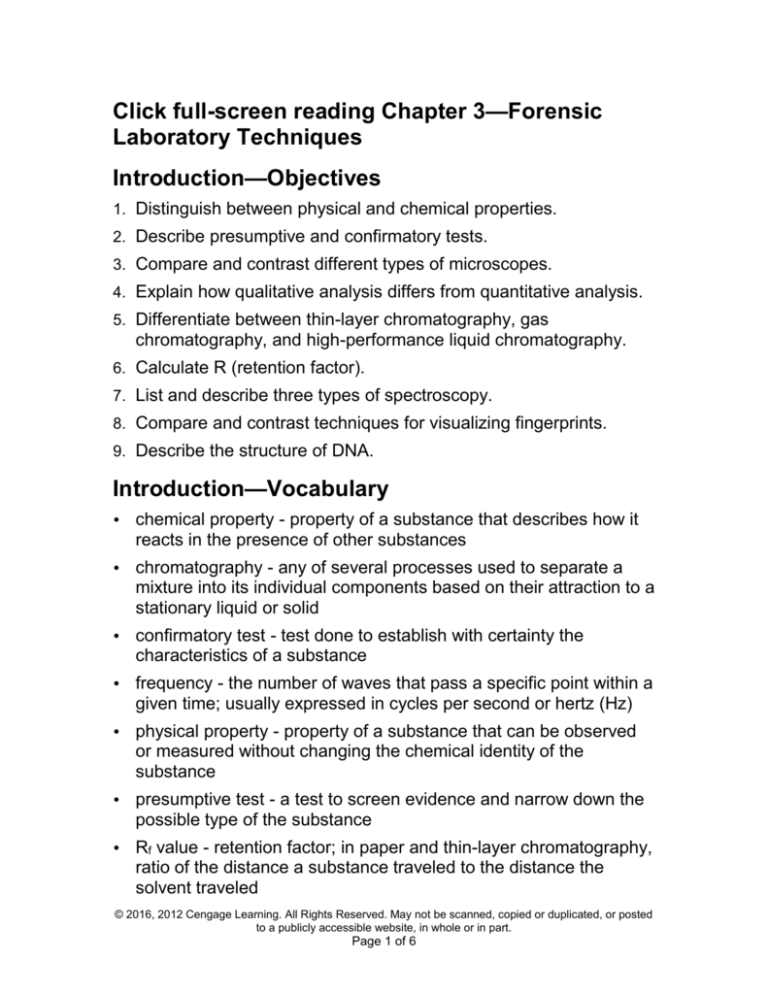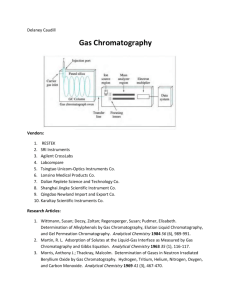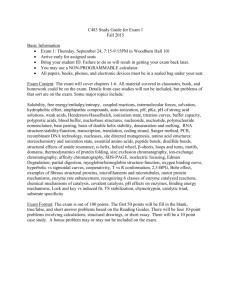
Click full-screen reading Chapter 3—Forensic
Laboratory Techniques
Introduction—Objectives
1. Distinguish between physical and chemical properties.
2. Describe presumptive and confirmatory tests.
3. Compare and contrast different types of microscopes.
4. Explain how qualitative analysis differs from quantitative analysis.
5. Differentiate between thin-layer chromatography, gas
chromatography, and high-performance liquid chromatography.
6. Calculate R (retention factor).
7. List and describe three types of spectroscopy.
8. Compare and contrast techniques for visualizing fingerprints.
9. Describe the structure of DNA.
Introduction—Vocabulary
chemical property - property of a substance that describes how it
reacts in the presence of other substances
chromatography - any of several processes used to separate a
mixture into its individual components based on their attraction to a
stationary liquid or solid
confirmatory test - test done to establish with certainty the
characteristics of a substance
frequency - the number of waves that pass a specific point within a
given time; usually expressed in cycles per second or hertz (Hz)
physical property - property of a substance that can be observed
or measured without changing the chemical identity of the
substance
presumptive test - a test to screen evidence and narrow down the
possible type of the substance
Rf value - retention factor; in paper and thin-layer chromatography,
ratio of the distance a substance traveled to the distance the
solvent traveled
© 2016, 2012 Cengage Learning. All Rights Reserved. May not be scanned, copied or duplicated, or posted
to a publicly accessible website, in whole or in part.
Page 1 of 6
wavelength - the distance between crests, or peaks, of two
consecutive waves
Where is Laci?
Laci Peterson — 27 and pregnant, disappeared from her home
Dec. 24, 2002
Grid pattern search along Dry Creek revealed no evidence
FBI joined the investigation
Concrete powder found in Peterson’s boat
Hair samples tested
Laci’s blood found on truck door
Introduction
Physical properties are properties that can be measured without
changing the identity of the evidence
Chemical properties determine how a substance behaves in the
presence of other substances.
Presumptive & Confirmatory Tests
Presumptive tests allow a field investigator to screen evidence to
reduce the number of possibilities and to get a preliminary
identification. (saliva, semen, blood, urine, and vaginal secretions)
Confirmatory tests are used to make a more specific
identification.
Microscopy—Compound Light Microscope
Most widely used microscope
Light source and multiple lenses
Magnifcation between 40x to 1000x
View hair, fibers, and cells
Microscopy—Stereomicroscope
Sometimes called a dissecting microscope
Light is reflected from the specimen surface
© 2016, 2012 Cengage Learning. All Rights Reserved. May not be scanned, copied or duplicated, or posted
to a publicly accessible website, in whole or in part.
Page 2 of 6
Produces a three-dimensional image useful for dissecting
Better surface details
Inspect insect larvae, paint chips, and other small items
Microscopy—Comparison Microscope
Two microscopes connected to one eyepiece
Two samples are visible side by side
Useful for comparing bullet striations, fibers, and hair
© 2016, 2012 Cengage Learning. All Rights Reserved. May not be scanned, copied or duplicated, or posted
to a publicly accessible website, in whole or in part.
Page 3 of 6
Microscopy—Electron Microscopes
Uses beams of electrons to form images
Magnification up to 500,000x
Black and white
Transmission electron microscope (TEM) passes electrons
through the sample to produce images of internal structures
Scanning electron microscope (SEM) passes electrons over the
surface to produce a three-dimensional image
Analytical Techniques
Quantitative — analysis results in a measurable amount
Qualitative — analysis results in a description or identification of
the components
Chromatography—Paper
Separates substances within a mixture based on their physical
properties
Substances adhere to solid surfaces or dissolve in a solvent
differently
Compare a known substance to an unknown one
Chromatogram—Rf value
Distance substance traveled
Distance solvent traveled
Chromatography—Other Types
Passes liquid or gas through a column or tube packed with a
porous solid material
Thin-layer chromatography (TLC)
Gas chromatography (GC)
High-performance liquid chromatography (HPLC)
© 2016, 2012 Cengage Learning. All Rights Reserved. May not be scanned, copied or duplicated, or posted
to a publicly accessible website, in whole or in part.
Page 4 of 6
Electromagnetic Radiation
Light travels in electromagnetic waves
Crest — highest point
Wavelength — distance between two consecutive crests
•
Frequency — how many waves pass through a point within a
given time period
Search for latent fingerprints
Locate trace evidence
Determine the structure of a molecule
Spectroscopy
Substances, when heated, emit light at a specific wavelength
Spectroscopy analyzes the light emissions to determine what
elements are present
Detects accelerants and explosive residues
Spectroscopy
Mass spectroscopy — combined with gas chromatography to
identify atoms and molecules by their masses
Atomic absorption spectroscopy (AAS) — measures the amount of
light of a specific wavelength absorbed by atoms of a substance
Ultraviolet (UV) spectrscopy — measures wavelengths of light;
used to determine the concentration of elements in a substance
Fingerprint-Developing Techniques
Dusting
Cyanoacrylate fuming
Ninhydrin
Diazofluoren
Silver nitrate
Vacuum metal deposition
© 2016, 2012 Cengage Learning. All Rights Reserved. May not be scanned, copied or duplicated, or posted
to a publicly accessible website, in whole or in part.
Page 5 of 6
DNA Analysis
Deoxyribonucleic acid — found in the cells of all organisms
DNA fingerprint is a DNA pattern that distinguishes one individual
from another
Chapter Summary
Physical properties are characteristics that can be observed and
measured without changing the chemical identity of the substance.
Chemical properties are characteristics that determine the way a
substance interacts with other substances.
Presumptive tests screen evidence for possible identification.
Confirmatory tests determine the identity of evidence.
The comparison microscope is one of the most useful tools in
forensic investigations because it allows for the side-by-side
comparison of samples.
Quantitative analysis will always produce a number or a
proportion. Qualitative analysis will always provide a description or
statement.
Chromatography is used to separate a mixture into its individual
components.
Wavelength = the distance between peaks of consecutive waves.
© 2016, 2012 Cengage Learning. All Rights Reserved. May not be scanned, copied or duplicated, or posted
to a publicly accessible website, in whole or in part.
Page 6 of 6








